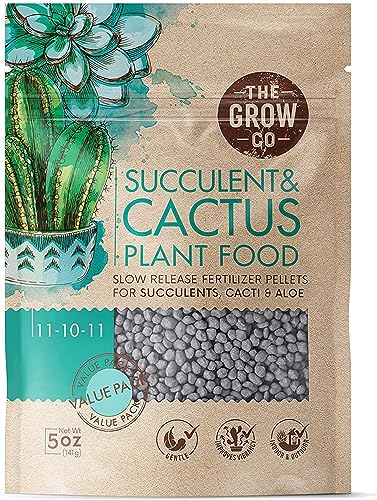Discover expert tips on growing succulents with ease! Learn how to care for these beautiful, low-maintenance plants and add charm to your space effortlessly.
Are you ready to transform your garden with stunning, low-maintenance plants? Growing succulents offers a unique and rewarding gardening experience, whether you’re a seasoned gardener or just starting out. These beautiful plants are not only easy to care for but also come in a variety of shapes and colors that can brighten up any space. Imagine having a garden that thrives on minimal water and attention, yet still captivates with its charm. In this guide, I’ll share everything you need to know about growing succulents, from choosing the right varieties to expert tips that will help you create a vibrant, drought-tolerant oasis. Let’s dive in and start your succulent journey today!
Choosing the Right Succulent Varieties for Your Garden
When it comes to growing succulents, selecting the right varieties for your space is key. With so many beautiful options out there, it can be overwhelming at first, but don’t worry—I’m here to help! Whether you’re looking for indoor beauties or outdoor wonders, there’s a succulent for every need. Let’s break it down so you can choose the perfect plants for your garden.
1. Consider Your Environment
Before diving into specific varieties, it’s important to assess your growing conditions. Succulents are quite versatile, but they do have certain preferences:
- Light: Most succulents thrive in bright, indirect sunlight, but some can tolerate lower light conditions. If you’re growing them indoors, place them near a sunny window or under grow lights.
- Temperature: Succulents generally prefer warm temperatures and may not survive frost. In cooler climates, consider bringing them indoors during the winter months or selecting hardier varieties.
- Space: Do you have a small indoor space or a large outdoor garden? Some succulents spread out, while others remain compact, so choose accordingly.
2. Popular Succulent Varieties
Here’s a list of some popular varieties you can start with:
- Aloe Vera: Perfect for sunny spots, Aloe Vera is not only beautiful but also has medicinal properties. It’s great for beginners and can grow both indoors and outdoors.
- Echeveria: Known for its stunning rosette shape, this succulent adds a pop of color to any garden. It’s perfect for containers or garden beds, thriving in dry, well-drained soil.
- Jade Plant: Often seen in home decor, the Jade Plant has thick, glossy leaves and is said to bring good luck. It grows well indoors and requires very little maintenance.
- Sedum (Stonecrop): Ideal for ground cover, Sedum is incredibly hardy and drought-tolerant. This variety works wonders for rock gardens or hanging baskets.
- Crassula (Silver Dollar Plant): With its rounded, silver-hued leaves, Crassula makes a striking addition to any garden, especially when planted in clusters.
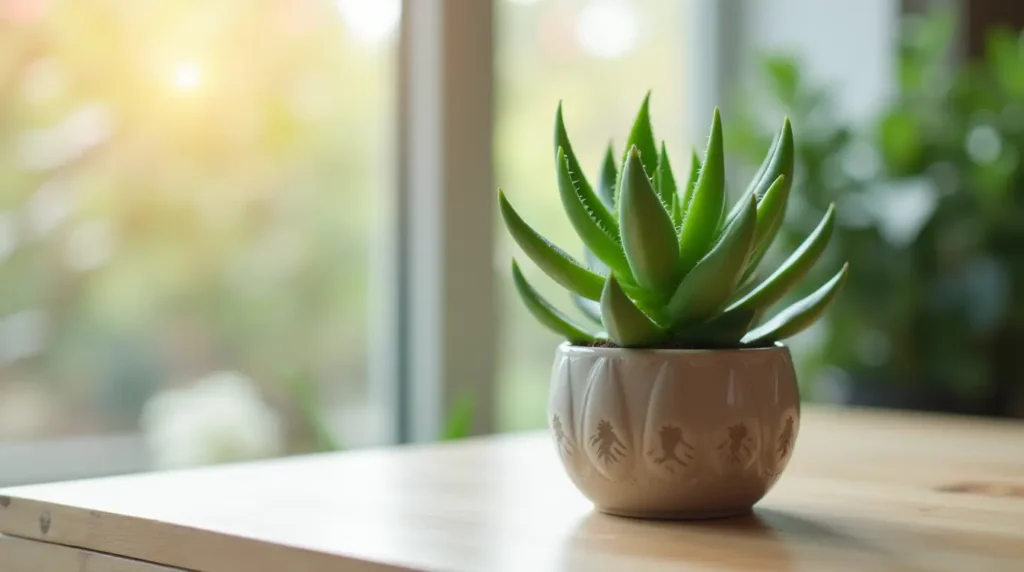
3. Indoor vs. Outdoor Succulents
- Indoor Succulents: These varieties are perfect for bringing some greenery indoors, especially if you’re working with limited space. Look for compact plants like Echeveria, Haworthia, and Aloe Vera. They do well in small pots on windowsills or desks.
- Outdoor Succulents: If you’re lucky enough to have outdoor garden space, succulents like Sedum, Agave, and Sempervivum are perfect for landscaping. They love sunny spots and will create an attractive, low-maintenance garden.
4. Selecting Based on Maintenance Needs
Succulents are generally low-maintenance, but some varieties require a little more care than others. If you’re a beginner, go for plants that thrive on neglect, like:
- Aloe Vera: Nearly indestructible, Aloe Vera is perfect for forgetful gardeners.
- Echeveria: These don’t need much attention and thrive in well-drained soil.
If you’re looking for something more involved, consider varieties like Agave, which may need occasional pruning and extra care in extreme heat.
5. Combining Succulents for Visual Appeal
One of the joys of growing succulents is how they can be arranged to create beautiful, dynamic displays. When mixing varieties, consider the following:
- Color: Mix succulents with different leaf colors for a vibrant look. Pair blue-toned varieties like Echeveria with green-hued Aloe Vera for contrast.
- Shape: Combine rosette-shaped plants like Echeveria with spiky varieties like Agave or Aloe Vera to create texture and interest.
- Size: Be mindful of plant sizes. Large varieties like Agave should be paired with smaller succulents like Sedum to prevent overcrowding.
Planting and Caring for Your Succulents
Now that you’ve selected the perfect succulent varieties for your garden, it’s time to dive into the exciting part—planting and caring for them! Succulents are some of the easiest plants to care for, but they still need a bit of attention to thrive. Don’t worry, though—I’m here to walk you through the steps. Whether you’re planting them in containers or directly in the garden, these practical tips will set you up for success.
1. Choosing the Right Pot for Indoor Succulents
If you’re growing succulents indoors, your pot choice plays a huge role in their success. Here’s what to keep in mind:
- Drainage is Key: Make sure your pot has drainage holes. Succulents don’t like to sit in water, and poor drainage can lead to root rot.
- Size Matters: Pick a pot that’s just slightly bigger than your plant’s root ball. Succulents don’t need large pots; too much space can lead to overwatering issues.
- Material: Terracotta pots are a great choice because they’re breathable and help prevent overwatering. However, you can also use plastic pots if they have proper drainage.
2. Preparing the Soil
Succulents prefer well-draining soil, so make sure you use the right mix. You can buy specialized succulent or cactus soil, but if you’re feeling DIY, here’s a simple recipe:
- 2 parts potting soil: Regular potting soil provides the base.
- 1 part sand: Sand improves drainage.
- 1 part perlite: Perlite helps with aeration and prevents soil compaction.
Mix these together for the perfect soil blend. If you’re planting outdoors, you can also amend your garden soil with sand and gravel to improve drainage.
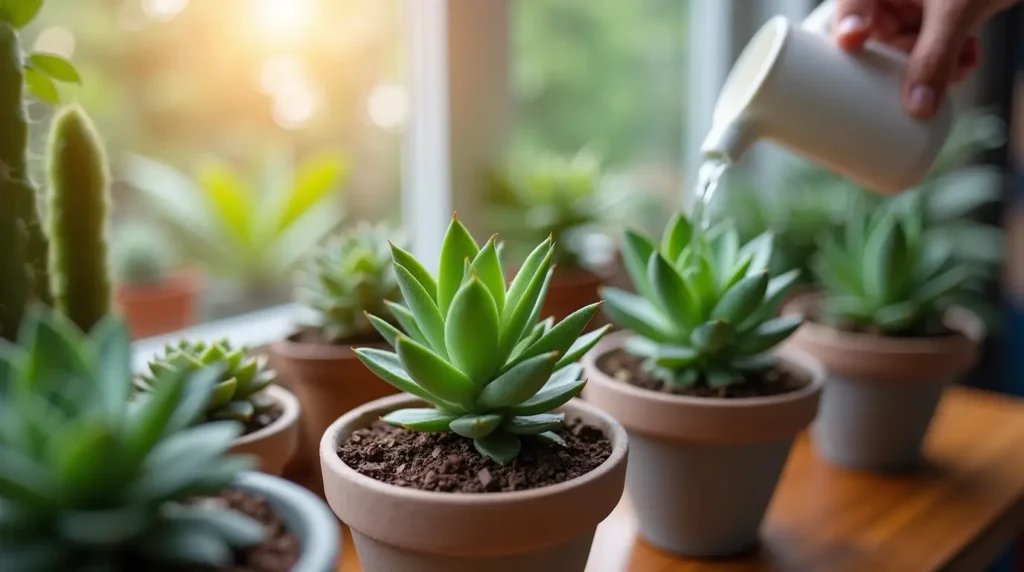
3. Planting Your Succulents
Planting succulents is a straightforward process. Follow these simple steps to give your plants the best start:
- Fill your pot halfway: Start by adding soil to your pot, leaving enough room for the plant’s root ball.
- Place your succulent: Gently remove the succulent from its nursery pot. Shake off any excess soil and place it in the new pot, ensuring the top of the root ball is level with the soil surface.
- Fill around the roots: Add more soil around the base of the plant, gently pressing it down to remove air pockets. Be careful not to bury the plant too deep.
- Water lightly: Succulents don’t like to be watered immediately after planting. Give them a light watering, just enough to settle the soil around the roots.
4. Watering Succulents the Right Way
One of the most common mistakes new succulent owners make is overwatering. Here’s how to avoid that:
- Water deeply, but infrequently: When you water, do so thoroughly until the water drains from the bottom. Let the soil dry out completely before watering again. For most succulents, watering once every 1-2 weeks is enough.
- Check the soil: Stick your finger into the soil to check if it’s dry. If it’s still moist, wait a few days before watering again.
- Watering in winter: Succulents go dormant in cooler months, so they need less water. Reduce watering to once a month during the winter.
5. Providing the Right Light
Succulents love sunlight, but too much direct sun can cause them to scorch. Here’s how to find the perfect light for your plants:
- Indoors: Place your succulents in a bright, sunny window that gets at least 6 hours of indirect sunlight per day. If you’re growing them in low-light spaces, consider using grow lights to supplement natural sunlight.
- Outdoors: For outdoor succulents, choose a location that gets plenty of sunlight, especially in the morning. Afternoon sun can be too intense and may burn your plants, so a spot with some afternoon shade works well.
6. Fertilizing Succulents
Succulents don’t need much fertilizer, but a little boost during their growing season (spring and summer) can help them thrive. Here’s what to keep in mind:
- Choose the right fertilizer: Use a balanced, water-soluble fertilizer diluted to half strength. A cactus or succulent-specific fertilizer works best.
- Fertilize sparingly: Fertilize your succulents once a month during their active growing season. Avoid fertilizing in the winter when they’re resting.
7. Pruning and Maintenance
Succulents are relatively low-maintenance, but regular pruning and maintenance will keep them looking their best:
- Remove dead or damaged leaves: Gently pull off any yellow or brown leaves at the base of the plant. This keeps your plant healthy and promotes new growth.
- Stem-cutting propagation: If your succulent has grown too leggy or long, you can prune the stems and propagate them to grow new plants.
Pro Tips for Thriving Succulents
By now, you’ve chosen your succulents and learned the basics of planting and care. But if you want your succulents to truly thrive and look their best, there are a few pro tips that can make all the difference. These expert insights will help you avoid common pitfalls and give your plants the extra care they deserve. Let’s dive into some advanced succulent care practices!
1. Managing Temperature Extremes
Succulents are tough, but they do have temperature preferences that can help them thrive. Here’s how to keep them happy in both hot and cold conditions:
- Hot Weather: Succulents love the warmth, but in scorching temperatures, they might need a little protection. If you’re growing them outdoors, consider using shade cloth during the hottest part of the day to prevent sunburn.
- Cold Weather: Most succulents don’t tolerate frost well. If you live in a colder climate, you can bring them indoors or create a simple frost protection by covering them with a blanket or moving them to a sheltered spot when temperatures drop.
2. Dealing with Pests
Though succulents are generally pest-resistant, they can still attract a few unwanted visitors. Here’s what to watch for and how to deal with them:
- Mealybugs: These tiny, white pests like to hide in the nooks of your plant. Use a cotton swab dipped in rubbing alcohol to remove them.
- Aphids: Aphids are small, green insects that can be found on new growth. You can remove them by gently spraying the plant with a mix of water and a drop of dish soap, or you can use insecticidal soap.
- Scale: Scale insects attach themselves to the plant’s stems and leaves. Scrape them off carefully with a soft brush or your fingernail.
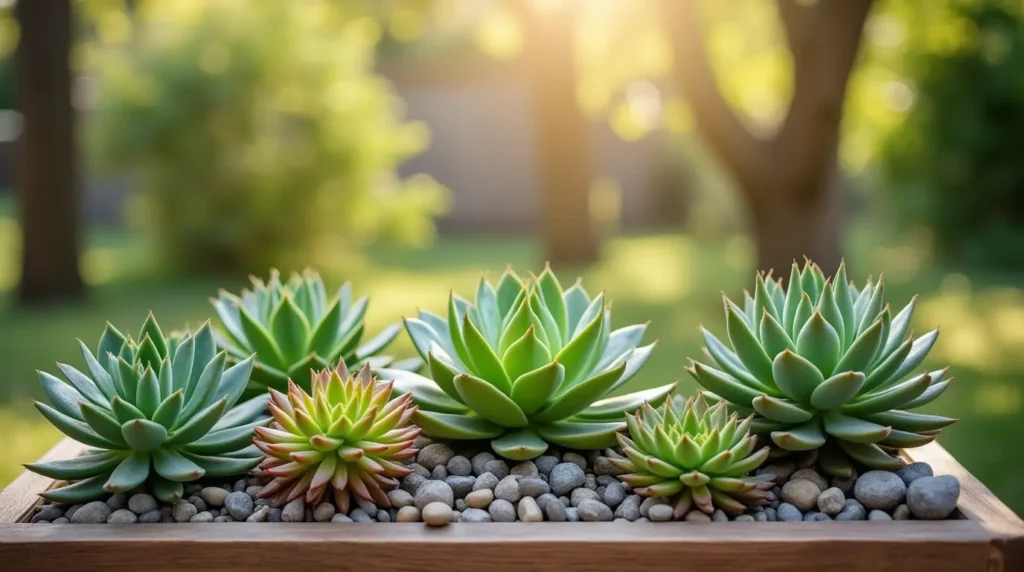
3. Propagating Succulents
Succulents are fantastic for propagation, meaning you can create new plants from your existing ones! Here’s how you can multiply your succulent collection:
- Leaf Cuttings: Gently twist off a healthy leaf from the plant. Let it sit out for a few days to callus over, then place it on well-draining soil. Water lightly when the soil is dry.
- Stem Cuttings: For a more established plant, cut a healthy stem and let it dry for a day or two. Once it’s callused, plant it in a small pot with cactus or succulent soil. Be patient—it might take a few weeks for roots to develop, but once they do, you’ll have a new plant!
- Offsets: Some succulents like Sempervivum (hens and chicks) grow small offshoots at the base. Gently remove the offset and plant it in its own pot.
4. Avoiding Common Succulent Problems
Even the best succulent owners face a few challenges. Here’s how to troubleshoot common issues:
- Leggy Growth: If your succulent starts looking long and stretched out, it might not be getting enough light. Move it to a brighter spot and cut back the leggy stems. They will soon grow back fuller and healthier.
- Overwatering: Succulents are much more likely to suffer from overwatering than underwatering. If your plant’s leaves are mushy or discolored, it’s a sign of root rot. To fix this, remove the plant from its pot, trim away any rotting roots, and repot it in dry soil.
- Discolored Leaves: Yellowing or browning leaves usually indicate a watering issue. Check your watering schedule and make sure the plant isn’t sitting in soggy soil.
5. Creating the Perfect Succulent Arrangement
Succulents look stunning when grouped together in arrangements, whether in pots, planters, or even terrariums. Here’s how to create your own masterpiece:
- Mix Colors and Textures: Pair plants with different colors, such as the deep red of Echeveria with the soft greens of Haworthia. Mixing textures, like the smooth leaves of Aloe Vera and the spiky ones of Agave, creates visual interest.
- Add Height: Use tall plants like Agave or Aeonium in the center or back of the arrangement, and surround them with smaller plants like Sedum or Crassula to create a tiered look.
- Containers: For a modern touch, try using concrete planters or metal containers. For a rustic look, go with terracotta or wood planters.
6. Seasonal Succulent Care
Succulent care changes with the seasons, so it’s important to adjust your routine. Here’s how to keep your plants happy year-round:
- Spring and Summer: During the growing season, succulents need more frequent watering. Keep them in full sunlight, and don’t forget to fertilize them once a month with a diluted liquid fertilizer.
- Fall and Winter: As succulents enter their dormant phase, reduce watering and stop fertilizing. Move them to a cooler spot if needed, and avoid exposing them to drafts or extreme cold.
Incorporating Succulents into Your Garden Design
Succulents aren’t just low-maintenance beauties—they’re also incredibly versatile when it comes to garden design. Whether you have a small balcony or a sprawling garden, succulents can add texture, color, and interest to your landscape. Let’s explore some creative ways to incorporate succulents into your garden and elevate your outdoor space.
1. Creating a Succulent Garden Bed
One of the most popular ways to showcase succulents is by creating a dedicated garden bed. Here’s how to make it a standout feature in your garden:
- Choose the Right Location: Pick a sunny spot with well-draining soil. Succulents love the sun, so aim for at least 6 hours of direct sunlight each day.
- Prepare the Soil: As mentioned before, succulents need well-draining soil. Amend your garden soil with sand, perlite, or gravel to enhance drainage.
- Planting Arrangement: Mix different types of succulents for visual interest. Use taller varieties like Agave or Aloe Vera as focal points, and surround them with smaller succulents like Sedum and Echeveria. Create clusters or patterns to make the bed look dynamic and natural.
- Maintenance: Keep an eye on watering—succulent garden beds should only be watered when the soil is completely dry. Mulching can help with moisture retention during hotter months, but avoid using organic mulch, as it can retain too much moisture.
2. Succulent Containers and Pots
If you don’t have a lot of space or prefer a more flexible arrangement, container gardening with succulents is a fantastic option. Containers allow you to move your plants around and create focal points wherever you need them. Here’s how to make your succulent pots shine:
- Mix and Match Pots: Experiment with different sizes, shapes, and materials. Try a combination of concrete, ceramic, terracotta, or even repurposed containers like old teacups or crates. The variation in textures adds to the visual appeal.
- Use a Variety of Succulent Types: Combine a variety of succulents in one container. For example, pair the rosette-shaped Echeveria with spiky Yucca or trailing String of Pearls for a striking contrast.
- Good Drainage: As always, ensure your containers have drainage holes to prevent water from sitting at the bottom and causing root rot.
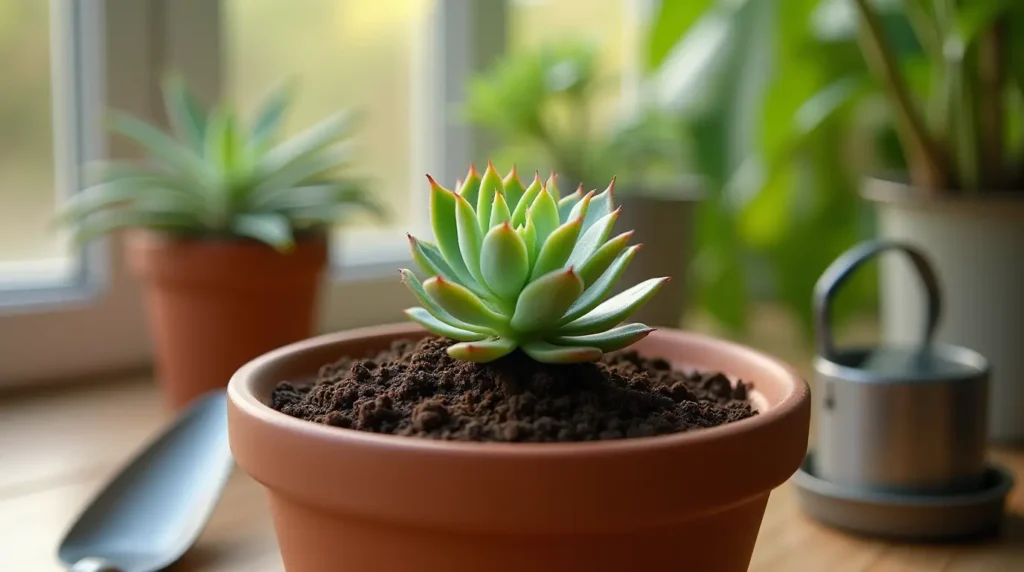
3. Succulents for Vertical Gardens
If you’re short on space or want to add a unique element to your garden, consider creating a vertical succulent garden. Vertical gardens are perfect for small yards, balconies, or even as a wall feature in larger gardens. Here’s how to get started:
- Choose the Right Structure: You can use a wall-mounted planter, a trellis, or even a repurposed wooden pallet to create a vertical garden. Just make sure it’s sturdy and can support the weight of your plants.
- Plant Selection: For vertical gardens, look for succulents that don’t require a lot of space to spread out. Sedum, Crassula, and Haworthia are great options. You can also add trailing plants like String of Pearls to create cascading effects.
- Installation: If you’re using a wooden pallet, fill each compartment with succulent-friendly soil and plant your succulents in layers. For wall-mounted planters, make sure each section has enough space for root growth.
4. Rock Gardens with Succulents
Succulents and rocks are a perfect match! A rock garden brings out the natural beauty of these plants while creating a low-maintenance and unique design. Here’s how to create a stunning rock garden:
- Use Large Stones: Arrange large stones or boulders in a visually appealing pattern. The stones create a rustic, natural feel, which complements the geometric shapes of succulents.
- Choose Drought-Tolerant Plants: Rock gardens are typically designed for arid environments, so use drought-tolerant succulents like Agave, Yucca, or Opuntia (prickly pear).
- Focus on Layering: Plant succulents around the rocks in clusters. Tall plants can be placed in the back, while low-growing plants should be used at the front to create depth and texture.
5. Succulents as Ground Cover
If you’re looking for an easy-care ground cover, succulents can be an excellent choice. They spread quickly and help prevent weeds from taking over your garden. Here’s how to use succulents as ground cover:
- Choose Spreading Varieties: Opt for succulents that naturally spread, like Sedum or Alyssum. These varieties will cover the ground quickly, forming a carpet of texture and color.
- Perfect for Dry Areas: Succulent ground cover works particularly well in dry or neglected spots where grass may struggle to grow. It’s a beautiful and practical solution for xeriscaping or low-maintenance gardens.
- Keep Them Trimmed: While they are low-maintenance, succulent ground covers may need occasional trimming to keep them tidy. Simply trim back any overgrowth to maintain their shape and prevent them from becoming too unruly.
6. Creating a Succulent Terrarium
If you’re looking for a way to enjoy succulents indoors, terrariums are a great option. They bring a little bit of greenery into your home while serving as a fun DIY project. Here’s how to build your own:
- Choose a Container: Pick a clear glass container like a jar, vase, or fishbowl. Ensure the container has no top or lid, as succulents need good air circulation.
- Layer the Materials: Start with a layer of small rocks or gravel for drainage, followed by activated charcoal to prevent odor. Then, add a layer of cactus or succulent soil, and plant your succulents.
- Decorate: Add decorative elements like pebbles, sand, or miniature figurines to give your terrarium a personalized touch. Just be careful not to overcrowd the plants.
- Water Sparingly: Terrariums tend to retain moisture, so water lightly and ensure that the soil is completely dry before watering again.
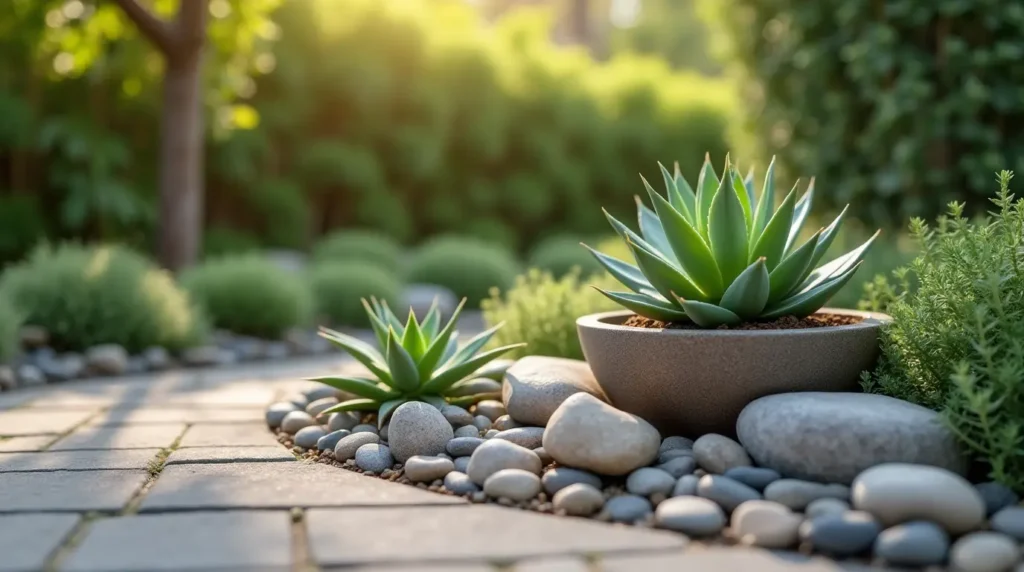
Conclusion:
Your Succulent Gardening Journey Begins
Now that you’re equipped with all the essential tips and techniques for growing succulents, it’s time to put your knowledge into action! Whether you’re just starting out or looking to take your succulent garden to the next level, remember that the key to success is patience, consistency, and a little creativity. Succulent gardening is not only rewarding but also incredibly fun, and with the right approach, you’ll enjoy lush, thriving plants year-round.
Key Takeaways for Thriving Succulents:
- Choose the Right Plants: Start with low-maintenance varieties that suit your climate and environment. Some great beginner-friendly succulents include Aloe Vera, Echeveria, and Jade Plant.
- Mind the Watering: Overwatering is the number one culprit when it comes to succulent care. Always ensure that the soil is completely dry before watering and make sure your plants are in well-draining pots or soil.
- Maximize Sun Exposure: Succulents thrive in bright, direct sunlight. Make sure they get at least 6 hours of sunlight per day to keep them healthy and vibrant.
- Don’t Forget Drainage: Succulents hate sitting in water, so always plant them in pots with drainage holes. This will prevent root rot and keep your plants healthy.
- Get Creative with Design: From garden beds and containers to vertical gardens and terrariums, there are endless ways to incorporate succulents into your outdoor and indoor spaces. Use them to add color, texture, and visual interest to any area.
Your Next Steps:
- Start Planting: Choose your favorite succulents, and start planting! Whether you’re creating a garden bed, designing a vertical wall, or arranging them in pots, make sure you choose the best location and soil conditions for each plant.
- Experiment and Learn: Succulent gardening is a wonderful opportunity for experimentation. Try different arrangements, colors, and techniques to see what works best for you and your garden.
- Stay Connected: Don’t hesitate to revisit this guide whenever you need a refresher. Gardening is a continuous learning process, and each plant you grow teaches you something new.
Succulent gardening is an incredibly fulfilling and accessible hobby that anyone can enjoy. So, why wait? Start your succulent gardening journey today and watch your plants grow into beautiful, low-maintenance wonders. Happy gardening!
Frequently Asked Questions (FAQs) About Growing Succulents
Now that you’ve learned all about growing succulents, you might have some lingering questions. Don’t worry—you’re not alone! Many gardeners, both beginners and experienced, have similar concerns when it comes to succulent care. In this section, we’ll answer some of the most common questions about succulent gardening to help you feel even more confident in your gardening journey.
Succulent Care FAQ
How often should I water my succulents?
Succulents don’t require frequent watering. Water deeply but infrequently, allowing the soil to dry out completely. In warmer months, water every 1–2 weeks. In colder months, reduce to once a month.
Can I grow succulents indoors?
Yes! Place them near a sunny, south-facing window, use well-draining soil, and rotate them occasionally to ensure even growth.
Why are my succulent leaves turning yellow or soft?
Yellowing leaves indicate overwatering or poor drainage. Soft, mushy leaves suggest root rot. Ensure the soil is dry before watering and use a well-draining pot.
How do I propagate succulents?
You can propagate succulents using leaf or stem cuttings. Allow them to dry for a few days before placing them on well-draining soil. Water lightly until roots form.
What are the best succulents for beginners?
Great options include Aloe Vera, Jade Plant, Echeveria, Sedum, and Hens and Chicks. These are easy to care for and resilient.
Can I grow succulents outside year-round?
In warm climates, yes. In colder climates, bring them indoors during winter or use frost protection.
How do I prevent pests on my succulents?
Check regularly for pests. Remove them with rubbing alcohol or use neem oil for infestations. Ensure good air circulation to prevent issues.
How can I tell if my succulent is healthy?
Healthy succulents have firm, plump leaves with vibrant color. Pale, mushy, or stretched-out plants may need more light or less water.
Source Links for Authority and Credibility
To improve the article’s authority, here are some high-quality, reputable sources related to growing succulents:
- University of California Agriculture & Natural Resources – Succulent Care Guide
🔗 https://ucanr.edu/sites/UrbanHort/Succulents/ - Royal Horticultural Society – Growing Succulents Indoors & Outdoors
🔗 https://www.rhs.org.uk/plants/types/succulents - The Spruce – Comprehensive Succulent Care Tips
🔗 https://www.thespruce.com/how-to-care-for-succulents-8637103 - Succulent and Sunshine – Expert Advice on Propagating Succulents
🔗 https://www.succulentsandsunshine.com/propagating-succulents/ - Better Homes & Gardens – Common Succulent Problems and Solutions
🔗 https://www.bhg.com/gardening/houseplants/care/common-succulent-problems/ - Drought-Resistant Plants: Beautiful Choices for a Water-Wise Garden







